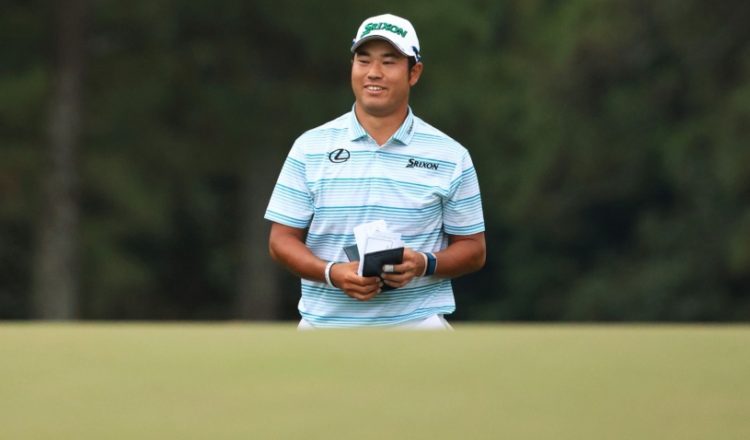The Japanese word senpai, simply translated, means ‘senior.’ It is both a natural and respectful way of referring to someone who is your elder.

A mentor, if you will.
But behind the simplicity of the word lies an entire subculture of unwritten laws and responsibilities that you take upon yourself as one’s senpai: leading by example, only to then pass down the knowledge and experience you’ve gained to the generation behind you.
This is true in school, business or even sport, and the onus of being one’s senpai will be with that person for life.
So, when it comes to the young career of Keita Nakajima—currently the top amateur golfer in the world—though his sights are set on achieving his life-long goal of playing on the PGA TOUR, he’s also focused on fulfilling a sacred responsibility passed down from senpai to senpai for centuries. He is playing the role of coach and mentor to underclassmen who look to him for guidance.
“I joined the team when I was 15 years old,” he said. “Back then, there were many senpai that I really looked up to. I was playing among them, but now I am the oldest on the team, and I hope to set a good example for the younger players that follow in my footsteps after I leave.”
That team Nakajima refers to is Japan’s national team, a squad that has produced the last two winners of the McCormack Medal awarded to the world’s top-ranked amateur: Nakajima and Takumi Kanaya. Both players have followed in the footsteps of Hideki Matsuyama by winning the Asia-Pacific Amateur and on the Japan Tour while still an amateur. This week, they’ll join Matsuyama in the field as he defends his Masters title.
Nakajima is in the field as the Asia-Pacific Amateur champion, while Kanaya earned his invitation by being ranked in the top 50 in the world.
Nakajima frequently credits Kanaya for being his senpai, calling him an integral part of his success.
“In following Takumi-senpai’s game, I’ve always felt that his putting was very clutch,” Nakajima said. “His mentality stays strong, and he never gives up, which is something I’ve always tried to replicate.”
Kanaya, 23, is already a three-time winner on the Japan Golf Tour. He has two top-10s on the PGA TOUR this season, a T7 at the ZOZO CHAMPIONSHIP in Japan and T9 at the World Golf Championships-Dell Technologies Match Play, and is a candidate for this year’s International Presidents Cup team.
As for Kanaya’s senpai? That’s none other than Matsuyama, a fellow Tohuku Fukushi University alum, and the first Japanese man to win a major. Matsuyama deflects any credit for the promising players who have followed in his footsteps, pointing instead to his predecessors.
“I’m really not the pioneer,” Matsuyama said. “There’s been so many others that have come before me and have laid the foundation for me to achieve this goal. So it’s not just me, but it’s all of those that have gone before me that have tried and struggled and put the work in and were great examples to me.”
Japan’s national team is the common thread that runs between the trio of young Japanese players who will compete at Augusta National this week. While the team has been around since 1984, it functions much differently today. It’s changed radically even from a decade ago when Hideki was a member.
“There were many good players in Japan, but instruction methods have changed,” said Andy Yamanaka, executive director and chairman of the Japan Golf Association. “In the past, it was customary that former players would eventually become the national team coach, however, our coaching methods have evolved to finding a coach who has actual coaching qualifications and studied instructional methods on being a coach.”
Aijiro Uchida, senior manager and high performance development director for the JGA, said the turning point came in 2006, when Japan finished fourth in a world championship.
“We felt something needed to change to enhance the level of our players,” Uchida said. “We didn’t have a traditional coach. We had a swing coach but no one who could offer advice in terms of physicality, mentality and dietetics. I went to Florida in 2011 and visited 10 academies known for their world-class coaches and, for the first time, I was introduced to a structure that united individual performance experts into a singular system in order to help develop a more holistic team.”
Uchida wondered if this method could apply in Japan.
“In 2014, when the world championship took place in Japan, I saw firsthand teams that employed that kind of system perform very well and realized if we didn’t change what we were doing, we would never be able to do better than fourth.”
The Japanese already had a firm understanding of sports science and nutrition, so it’s an easy assumption that the golf team’s coach would come from the golf-crazed land of Japan. That was not the case, however. Instead, an Australian, Gareth Jones, was called upon to help the Japanese national golf team.
“I guess they’d seen me around through the Asia Pacific quite a bit and we connected,” Jones said. “I guess my personality, or what they thought was my personality, was going to suit what they wanted to do. And my background coming from elite development was then, I guess, the match.”
Jun Nagashima, assistant manager of high-performance development at JGA said Jones offers a perfect blend of Eastern and Western methods.
“Gareth has successfully combined his own essence of coaching golf with Japanese sports science, while also taking Australia’s Western culture and open-minded atmosphere and integrating that into Japan’s Eastern senpai culture and humility, and then individualizing those philosophies down to each individual player,” Nagashima said. “Today’s program transcends nationalities and is borderless between Japan and other countries.”
Jones adds: “We had sports sciences involved, we had strength and conditioning. We had psychology. When I came in, I really wanted to try and bring even more sports science involvement into the program, but have it that sports science was involved in performance as well.”
Jones also changed how the Japanese team prepared for events, shifting the focus from the practice area to on-course strategy and performance.
Access to golf courses is one of the major obstacles that golfers, especially juniors, face in Japan is. Most people spend an exorbitant amount of time at a driving range because that’s the only practice area they can get to.
“(Keita) had won the Australian Amateur Championship. He’s won the Asia Pacific last year. It was only in the last couple of years he actually got membership to a golf club, which to me is incredible. The level of the play of these players is phenomenal and they don’t have access to golf courses like the juniors do (in Australia),” Jones said.
As of 2021, there are 2,151 golf courses in Japan and approximately 4,000 indoor/outdoor practice facilities.
Jones’ philosophy is to practice more efficiently. Less is more, where in general Japanese athletes will do the opposite.
“When you practice for long, long periods of time, generally the intensity goes down. So we’ve tried to employ a method of what’s called deep practice and that’s coming from the research, from guys like Daniel Coyle, an author that’s published around this subject. It’s raising intensity and is not specific to golf,” Jones said. “We really focus on the scoring zones. These are high performing players; we have to get a result. We tend to focus 65% short game, 35% long game. That’s our mantra. And we’ve probably flipped what they used to do. It was probably 80% long game, 20% short game.”
Another thing that does not work in Japan’s favor is its ‘bukatsu’ mentality. Youth sports are not necessarily seasonal like you will often find in the United States, where kids jump from soccer to baseball, then football to basketball, depending on the time of year. Kids in Japan will join a ‘bukatsu’ program and focus on a single interest, which could be anything from music, sport, art and science, but from a very early age a child will often specialize in one thing.
“They’re missing out on other activities that help balance their bodies properly. Let alone playing team sports, which might give them a little bit more humility as well,” Jones said. “So, we really try to push that kids have multiple activities in their life. We’re trying to push a long term athlete development program or focus. When you play a sport like golf, you’re going in one direction all the way. So, we end up with muscle imbalances. Their muscles are not developing necessarily in the right way. So, we have more injuries.”
Apart from practice methodology and specializations, language for obvious reasons was also another major obstacle that Jones and the team needed to overcome.
Due to COVID, Jones has not been to Japan in more than two years, and he and his team have had to pivot and adjust how they communicate with each other. Jones and Nakajima have weekly virtual lessons where Nakajima is hooked up to monitors with video and Trackman data being shared back to Jones, who joins remotely from his home in Adelaide, Australia.
“It’s a means to an end,” he continues. “It’s something we have to do. It’s better than doing nothing. We’ve learned some things over the last few years that we’ll continue to do as well.”
The sentiment holds true to what has naturally become the team’s motto, “JKG.”
Just Keep Going.
“It’s not about shooting course records every day,” Jones said. “We’re gonna have bad days, and good days. But if we can learn something, just get that little bit better, just learn something every day.”
Regardless of what era any player on the national team was a part of, they feel it’s their responsibility when they become the senpai player to influence the younger players.
It’s like passing the baton in a relay race, and now it’s Nakajima running anchor in his final race.
“What they’ve learned, they can then pass that onto future generations, and Hideki has been a massive influence over all of these players,” Jones said. “It’s a cultural thing, but it’s also a responsibility, and that’s the great thing, the players take that responsibility seriously.”
They recognize the responsibility that comes with being a senpai.













